Concourse, Bronx
| Concourse | |
|---|---|
| Neighborhood of the Bronx | |
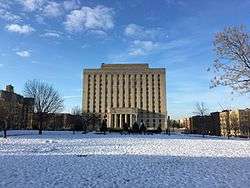 Bronx Courthouse serves as Bronx Borough Hall | |
|
Location in New York City | |
| Coordinates: 40°49′37″N 73°55′23″W / 40.827°N 73.923°WCoordinates: 40°49′37″N 73°55′23″W / 40.827°N 73.923°W | |
| Country |
|
| State |
|
| City |
|
| Borough |
|
| Population (2010) | |
| • Total | 75,371[1] |
| ZIP Codes | 10451, 10452, 10456 |
| Area code | 718, 347, 929, and 917 |
Concourse is a neighborhood in the southwestern section of the New York City borough of the Bronx which includes the Bronx County Courthouse, the Bronx Museum of the Arts, and Yankee Stadium. The neighborhood is divided into three subsections: West Concourse, East Concourse, and Concourse Village.[2][3][4][5]
Location
The neighborhood is in the South Bronx in the southwestern part of the borough, centered on the intersection of Grand Concourse and 161st Street.[6] It is bordered to the west by Highbridge and the Harlem River; to the north by Mount Eden; to the east by Claremont Village, Melrose, and Morrisania; and to the south by Mott Haven.[7]
The neighborhoods follows a street grid with avenues crossing east/west streets. Retail is located on streets, and with the exception of Morris Avenue, the avenues are largely residential above 153rd Street. The neighborhood character is more industrialized along the river with the exception of park space and the Bronx Terminal Market. Other large retail nodes are located on 161st Street and adjacent blocks, at Concourse Plaza. Smaller retail nodes are located on 165th Street and on 167th Street.[7]
The elevation varies from sea level at the Harlem River short to its highest point of elevation of 110 feet (34 m) in Franz Sigel Park. In fact, George Washington and his troops utilized some of these elevations during the American Revolutionary War as vantage points to monitor activity along the Harlem River.[8] Elevation can vary quickly with the Grand Concourse 20 feet higher than adjacent avenues in some instances.
History
Early history
From European settlement through the late 1800s, the Concourse area occupied wooded lands and rocky formations within and on the periphery[6] of the estate of the prominent Morris family who farmed in what is now Southwest Bronx.[9] Until 1845, the area was part of the Town of Westchester within Westchester County. After the subdivision of the Town of Westchester in 1845, the Concourse area became part of the Town of West Farms. In 1855, West Farms was further subdivided and the Town of Morrisania was created.[10]
With the promise of city services, the Morrisania along with the Towns of West Farms and Kingsbridge seceded from Westchester County to join Manhattan as part of New York County. The three towns were referred to as the "Annexed District".[10] In 1896, the vast majority of what is now the Bronx joined New York County. In 1898 the City of Greater New York and Borough of the Bronx[11] were formed, and all former Westchester County annexations within New York County were reconstituted into the independent County of the Bronx in 1914.
20th century
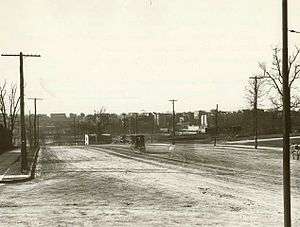
Expansion of the subway system enabled rapid development of the Concourse. The first subway crossed under 149th Street into the area in 1906 and is now the IRT White Plains Road Line (2 and 5 trains). The IRT Jerome Avenue Line opened a decade later in 1917 and spurred enormous development in the area.[6] Concurrent with subway development and inspired by the City Beautiful movement, the New York City built the Grand Boulevard and Concourse (shortened to the Grand Concourse). Modeled after Paris’ Champs-Élysées, the original boulevard stretched from the Bronx Courthouse to near Van Cortlandt Park, but was later extended south to 138th Street by supplanting an the existing Mott Avenue.[6] The Grand Concourse was further improved by the extension of the IND Concourse Line under most of its length in 1933.[11]
Yankee Stadium was built 1923 when Jacob Ruppert moved the team from the Polo Grounds in Manhattan, where the Yankees shared space with the New York Giants, to the Bronx. With the exception of a brief period in the 1970s, the Yankees have been in Concourse for almost 100 years.

Infrastructure and services brought residents. Some of the 500,000 people who moved to the borough in the 1920s lived in the Concourse.[12] The new construction to accommodate those residents was inspired by the City Beautiful movement and the 1901 Tenement House Act, which mandated light, air, and fire protection.[3] This yielded 5- and 6- story multifamily residential buildings throughout the neighborhood built in a variety of styles from Tudor, Renaissance, and Colonial Revival to Art Deco and Art Moderne.[3]
In the late 1930s the Works Progress Administration dubbed the area “the Park Avenue for the Middle Class”, and the area maintained that reputation through the 1950s. The Concourse inspired visits by presidential candidate Franklin D. Roosevelt, Harry S. Truman, and John F. Kennedy. However, after 1960, the area began to decline quickly due to white flight, incentives to move to the suburbs, redlining, the development of Co-Op City, disinvestment by New York City, and arson.[3] While no buildings burned down in the Concourse during the period,[6] the population of the area declined until the 1990s when the population started to rebound.[13]
21st century
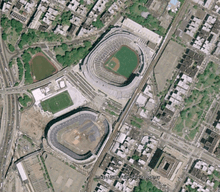
Recent developments in the Concourse include construction and neighborhood improvements, and the neighborhood is gentrifying as of 2012.[13] The Yankees built a new stadium in 2009. The former stadium was demolished; a large public park—Heritage Field—was established in its place. The Bronx Museum of the Arts undertook a major expansion in 2006, and is currently exploring another addition. The Bronx Hall of Justice opened in 2007. The Bronx Terminal Market opened in 2009 as did the adjacent Mill Pond Park, which includes a Stadium Tennis Center.
The New York City Department of Transportation is in the process of making capital, aesthetic, and safety improvements to the Grand Concourse with much of the work completed within the Concourse neighborhood.[14] A redesign of 161st Street during the 2000 reconstruction of the Grand Concourse brought additional pedestrian space to the neighborhood. In 2011, the NYC Landmarks Preservation Commission designated a large portion of the neighborhood as the Grand Concourse Historic District.[3] A rezoning of 161st Street is expected to bring further development to the neighborhood along its principal east-west commercial corridor.
In 2016, the New York City Economic Development Corporation issued requests for proposals for a new redevelopment project in the Concourse, along the Harlem River shore. A $300 million proposal, announced in September 2017, includes 1,045 affordable housing units as well as a new Universal Hip Hop Museum that is to open in 2020. The first of two phases will have 600 affordable unites, a 2.3-acre (0.93 ha) waterfront promenade, a public plaza, a performance space, a movie theater, and the hip hop museum.[15]
The area was becoming more middle class since the 2000s. In the 2010 census, there were 3,055 non-Hispanic White residents in Concourse, having increased from 2,600 in the 2000 census. As of the 2010 census, the Concourse neighborhood had seen its first net increase in population in 40 years.[13]
Parks
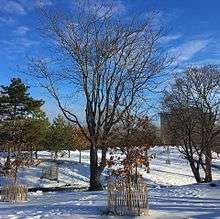
Concourse contains five separate parks and a plaza. At the center of the neighborhood and to the north of Bronx Courthouse, Joyce Kilmer Park and Lou Gehrig Plaza border the intersection of the Grand Concourse and 161st Street. Originally call Concourse Plaza, Joyce Kilmer Park was named for the author of the poem "Tree" in 1926.[16] Joyce Kilmer Park contains the Lorelei Fountain which celebrates the German poet Heinrich Heine. The park is flat with many walking paths. Formerly a parking lot, Lou Gehrig Plaza connects bridges 161st Street between the Bronx Courthouse and Joyce Kilmer Park.[6]
To the south of Bronx Courthouse, Franz Sigel Park offers a more rustic park space. Named for Franz Sigel, a patriot and educator in his native Germany and the United States who lived in the area until his death in 1902, the park is characterized by variations in elevation and bedrock. Formerly part of a Native American trail, a visitor can view Manhattan and surrounding rooftops from the terrace within the park. The park was extended in the 1960s to include a ball fields on the south side. A comfort area was added in 1993.[8]
Mullaly Park, named for reporter and park advocate John Mullaly, is an active-use recreational space with a pool and a skate park.[17]
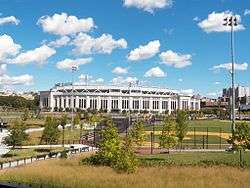
Expanded in 2009, Macombs Dam Park includes the 400-meter Joseph Yancy Track and Field, all weather turf, a soccer field, a baseball field, and grandstand seating for 600 people. The park, on the site of the original Yankee Stadium south of 161st Street and west of River Avenue, connects to the Yankees–East 153rd Street station on the Metro-North Railroad's Hudson Line.[18]
Construction started on Mill Pond Park in 2006 and ended in 2009. Located between the Harlem River and River Avenue adjacent to Bronx Terminal Market, the Park features Stadium Tennis Center, walking paths, picnic areas, and views of the waterfront.[19] The second floor of the Power house in Mill Pond Park is the future home of the Bronx Children's Museum.[20]
Transportation

The Harlem River separates the Bronx and Manhattan, with the Macombs Dam Bridge connecting the two boroughs within Concourse. Interstate 87, the Major Deegan Expressway, has exits that can access the neighborhood. The Grand Concourse terminates onto roads leading across the Triborough Bridge with connections to Queens and Manhattan.[7]
New York City Subway routes include the IRT Jerome Avenue Line (4 train) at 161st Street and 167th Street, and the IND Concourse Line (B and D trains) at 161st Street and 167th Street.[21] MTA Regional Bus Operations also operates routes in the area, comprising the Bx1, Bx2, Bx6, Bx6 SBS, Bx13, and Bx35 local routes as well as the BxM4 express route.[22]
The Metro-North Railroad has a commuter rail station at Melrose.[23]
Points of interest
The neighborhood hosts a variety of institutions including:
- Andrew Freedman Home[23]
- BronxWorks[23]
- Bronx Museum of the Arts[23]
- Bronx Courthouse[23]
- Yankee Stadium[23]
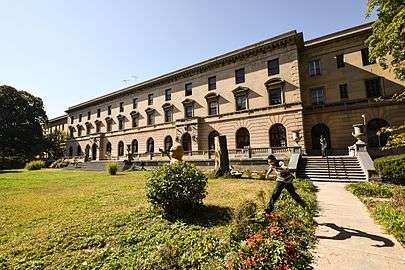 Andrew Freeman Home
Andrew Freeman Home- Bronx Museum of the Arts
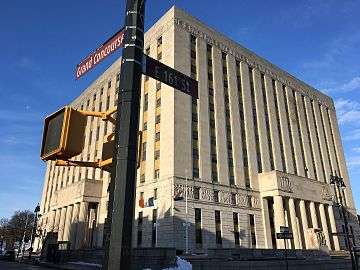 Bronx Courthouse at 161st and Grand Concourse
Bronx Courthouse at 161st and Grand Concourse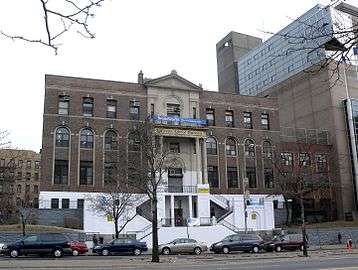 BronxWorks
BronxWorks Yankee Stadium
Yankee Stadium
References
- ↑ "Fact Sheet". US Census Bureau. pp. Zip Code Tabulation Area 10452. Retrieved March 13, 2017.
- ↑ "Bronx Community Board 4". www.nyc.gov. Retrieved March 14, 2017.
- 1 2 3 4 5 NYC Landmarks Preservation Commission (October 25, 2011). "Grand Concourse Historic District Designation Report" (PDF). www.nyc.gov. Retrieved March 13, 2017.
- ↑ "A Local's Guide to Grand Concourse, a Diverse Neighborhood Along a Historic Boulevard". Curbed NY. April 12, 2016. Retrieved March 14, 2017.
- ↑ "City Living: Where to eat, party and more in Grand Concourse". am New York. Retrieved March 14, 2017.
- 1 2 3 4 5 6 Casari, William (2008). "Concourse Dreams: A Bronx Neighborhood And Its Future". Hostos Community College. CUNY Academic Works.
- 1 2 3 Google. "Concourse, Bronx, NY" (Map). Google Maps. Google.
- 1 2 "Franz Sigel Park Highlights : NYC Parks". www.nycgovparks.org. Retrieved March 17, 2017.
- ↑ "South Bronx and the days of new American aristocracy - The Bowery Boys: New York City History". The Bowery Boys: New York City History. April 21, 2011. Retrieved March 14, 2017.
- 1 2 "History of the Bronx - Yes The Bronx". www.yesthebronx.org. Retrieved March 14, 2017.
- 1 2 "The Bronx County Historical Society - Bronx History". bronxhistoricalsociety.org. Retrieved March 14, 2017.
- ↑ New York City Planning Commission. "CITY PLANNING COMMISSION - Rezoning C 090365 ZMX" (PDF). www.nyc.gov/planning. Retrieved October 3, 2017.
- 1 2 3 Berger, Joseph (2012-03-25). "Grand Concourse Neighborhood in the South Bronx Gentrifies". The New York Times. ISSN 0362-4331. Retrieved 2017-05-11.
- ↑ "NYC DOT - DOT and community leaders unveil a 'grand' new Grand Concourse for the Bronx". www.nyc.gov. Retrieved March 14, 2017.
- ↑ Rosenberg, Zoe (2017-09-22). "Universal Hip Hop Museum gets a home at massive Bronx affordable housing development". Curbed NY. Retrieved 2017-09-26.
- ↑ "Joyce Kilmer Park Highlights : NYC Parks". www.nycgovparks.org. Retrieved March 17, 2017.
- ↑ "Mullaly Park Highlights : NYC Parks". www.nycgovparks.org. Retrieved March 17, 2017.
- ↑ "Macombs Dam Park : NYC Parks". www.nycgovparks.org. Retrieved March 17, 2017.
- ↑ "Mill Pond Park : NYC Parks". www.nycgovparks.org. Retrieved March 17, 2017.
- ↑ Wirsing, Robert (July 24, 2017). "Bronx Children's Museum construction begins". Bronx Times. Retrieved 13 July 2018.
- ↑ "Subway Map" (PDF). Metropolitan Transportation Authority. January 18, 2018. Retrieved January 18, 2018.
- ↑ "Bronx Bus Map" (PDF). Metropolitan Transportation Authority. September 2017. Retrieved April 24, 2018.
- 1 2 3 4 5 6 "MTA Neighborhood Maps: Grand Concourse / Yankee Stadium" (PDF). mta.info. Metropolitan Transportation Authority. 2018. Retrieved October 1, 2018.
External links
